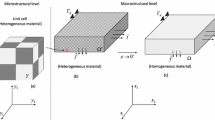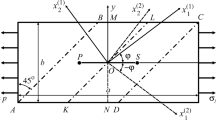Abstract
Eleven two-dimensional photoelastic models of fiber-reinforced composite-material configurations were designed for the purpose of investigating the effects of various fiber-end shapes, various fiber arrangements and broken fibers on the shear-stress distribution in an elastic matrix. Maximum shear stresses in the matrix in the vicinity of fiber discontinuities are presented. The peak stress resulting from a gradually tapered fiber was found to be slightly higher than that from a square-ended fiber, and a round-ended fiber produced a peak stress which was slightly lower than that from the square-ended fiber. Peak stresses resulting from two square-ended fibers butted closely together were considerably higher and decreased with increasing gap length between fiber ends. It made little difference whether the gap between the butted fiber ends was open, simulating a void resulting from a broken fiber, or filled with matrix material.
Similar content being viewed by others
References
Dow, N. F., “Study of Stresses Near a Discontinuity in a Filament-Reinforced Composite Metal,” Rpt. No. R63SD61, General Electric Missile and Space Div., Space Sci. Lab., Mechanics Sect. (August 1963).
Schuster, D. M., andScala, E., “The Mechanical Interaction of Sapphire Whiskers with a Birefringent Matrix,”Trans. Metallurgical Soc. AIME,230,1635–1640 (December 1964).
Scala, E., “Design and Performance of Fibers and Composites,” Fiber Composite Materials (papers presented at a Seminar of the Am. Soc. Metals, Oct. 17 and 18, 1964), Am. Soc. for. Metals, C. 7, 133–135 (1965).
Rosen, B. W., “Mechanics of Composite Strengthening,” C. 3, Ibid., Fiber Composite Materials (papers presented at a Seminar of the Am. Soc. Metals, Oct. 17 and 18, 1964), Am. Soc. for Metals, 43–44.
Sutton, W. H., “Development of Composite Structural Materials for Space Vehicle Applications,”Jnl. Am. Rocket Soc.,32 (4), (April 1962).
Mindlin, R.D., “Influence of Couple-stresses on Stress Concentrations,”Experimental Mechanics,3 (1),1–7 (1963).Discussion—C. W. Bert, Ibid.,Experimental Mechanics,(12), 307–308.
Sadowsky, M. A., Hsu, Y. C., and Hussain, M. A., “Boundary Layers in Couple-Stress Elasticity and Stiffening of Thin Layers in Shear,” Watervliet Arsenal Tech. Rpt. AD-WVT-RR-6320 (October 1963).
Sadowsky, M. A., and Weitsman, Y., “Effect of Poisson's Ratio of an Elastic Filler on Force Transfer between Embedded Microfibers,” Ibid., Watervliet Arsenal Tech. Rpt. AD-WVT-RR-6320 WVT-RR-6108-R (September 1962).
MacLaughlin, T.F., “Photoelastic Investigation of Shear Stress Distribution in Fiber-Reinforced Materials,” Ibid., Watervliet Arsenal Tech. Rpt. AD-WVT-RR-6320, WVT-RR-6220 (December 1962).
Sadowsky, M. A., Hsu, Y. C., and Hussain, M. A., “Effect of Couple-Stresses on Force Transfer Between Embedded Microfibers,” Ibid., Watervliet Arsenal Tech. Rpt. AD-WVT-RR-6320, AD-WVT-RR-6407 (June 1964).
Author information
Authors and Affiliations
Rights and permissions
About this article
Cite this article
MacLaughlin, T.F. Effect of fiber geometry on stress in fiber-reinforced composite materials. Experimental Mechanics 6, 481–492 (1966). https://doi.org/10.1007/BF02326519
Issue Date:
DOI: https://doi.org/10.1007/BF02326519




